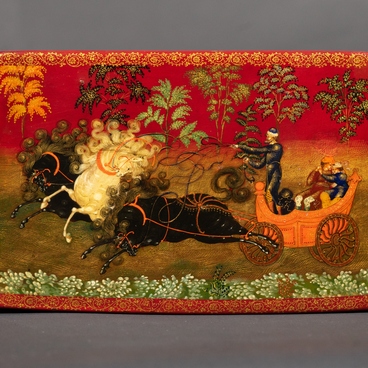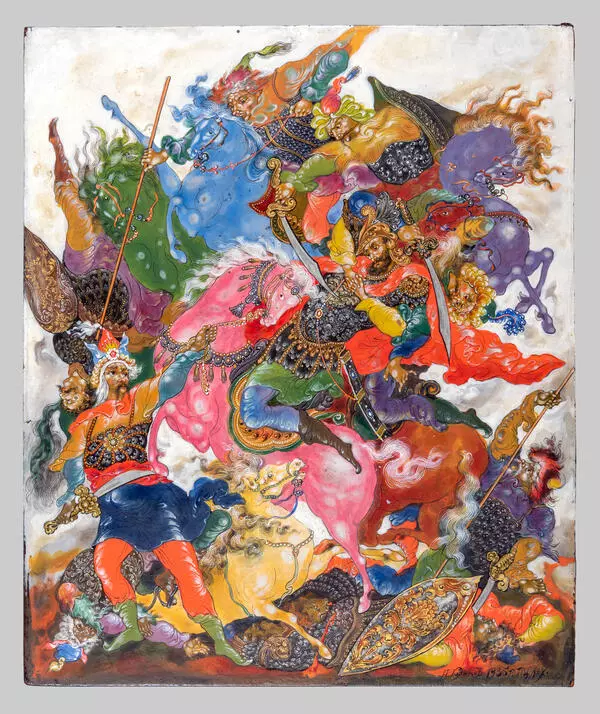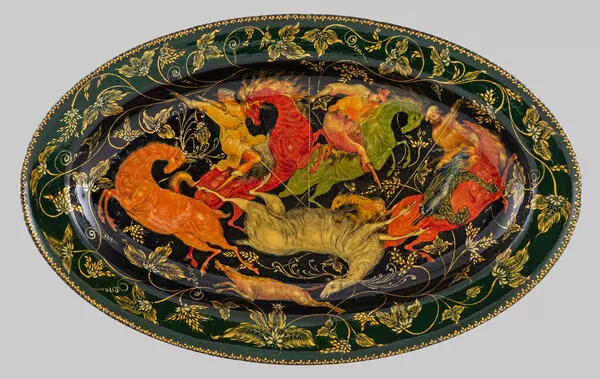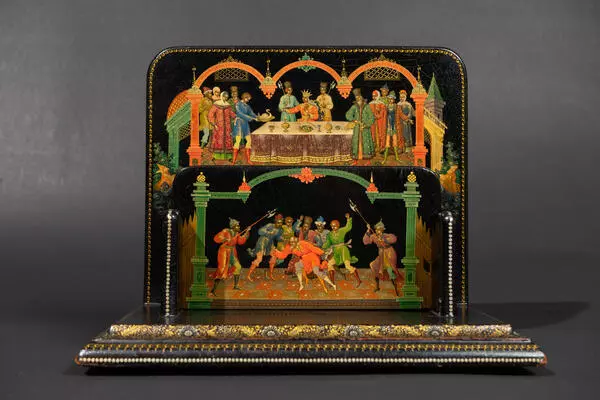The plate “Artel of Ancient Russian Painting” is one of its kind. It was created by special order for the International Exhibition of Modern Decorative and Industrial Arts, which was held in 1925 in Paris. The plate was supposed to represent the Palekh delegation at the exposition. Its individual parts were created by three of the greatest masters of Palekh miniature: Alexander Glazunov, Ivan Golikov and Alexander Kotukhin.
Palekh is a traditional center of icon painting, famous since the 17th century. Palekh icon masters painted churches all over Russia and abroad. They passed their skills from generation to generation; however, after the revolution of 1917, the government began a campaign against religion, and the former icon painters had to adapt to new conditions.
On December 5, 1924, the Palekh masters established the “Artel of Ancient Russian Painting”. Its participants developed a new artistic style: it combined traditions of Russian icon painting, practices of lacquer miniatures of Eastern countries and Western Europe, as well as folk art elements.
From the very beginning, the Artel helped artists to master the basics of miniature painting on papier mâché. At the same time, the artists did not use oil paints (as did the Lukutin Factory in Fedoskino), but tempera — paint based on egg yolk, which was traditional for icon painting. Bright images on a black background were inspired by fairy tales, oral epics and songs. Furthermore, they preserved the elegance of Russian icon painting style.
The founders of the Artel were Ivan Golikov, Ivan Bakanov, brothers Ivan and Alexander Zubkov, Ivan Markichev, brothers Alexander and Vladimir Kotukhin. Alexander Kotukhin was chosen as the first head of the Artel. In 1925, Alexey Vatagin, Grigory Bakanov, Dmitry Butorin joined the artists’ community. Ivan Vakurov joined in 1926. The works of all these artists are housed in the museum.
It is important to note that the masters did not only paint chests or boxes, their range was quite extensive: brooches, boxes for beads, barrels, notebooks, cases for stamps, snuffboxes, cigarette cases, cigar cases, powder bowls, eyeglass cases, teapots, boxes for gloves, and other stationary items.
The first experiments of the Palekh masters were a true sensation, their works displayed at foreign exhibitions received international recognition. The 1920s and 1930s are considered the heyday of this art.
Palekh is a traditional center of icon painting, famous since the 17th century. Palekh icon masters painted churches all over Russia and abroad. They passed their skills from generation to generation; however, after the revolution of 1917, the government began a campaign against religion, and the former icon painters had to adapt to new conditions.
On December 5, 1924, the Palekh masters established the “Artel of Ancient Russian Painting”. Its participants developed a new artistic style: it combined traditions of Russian icon painting, practices of lacquer miniatures of Eastern countries and Western Europe, as well as folk art elements.
From the very beginning, the Artel helped artists to master the basics of miniature painting on papier mâché. At the same time, the artists did not use oil paints (as did the Lukutin Factory in Fedoskino), but tempera — paint based on egg yolk, which was traditional for icon painting. Bright images on a black background were inspired by fairy tales, oral epics and songs. Furthermore, they preserved the elegance of Russian icon painting style.
The founders of the Artel were Ivan Golikov, Ivan Bakanov, brothers Ivan and Alexander Zubkov, Ivan Markichev, brothers Alexander and Vladimir Kotukhin. Alexander Kotukhin was chosen as the first head of the Artel. In 1925, Alexey Vatagin, Grigory Bakanov, Dmitry Butorin joined the artists’ community. Ivan Vakurov joined in 1926. The works of all these artists are housed in the museum.
It is important to note that the masters did not only paint chests or boxes, their range was quite extensive: brooches, boxes for beads, barrels, notebooks, cases for stamps, snuffboxes, cigarette cases, cigar cases, powder bowls, eyeglass cases, teapots, boxes for gloves, and other stationary items.
The first experiments of the Palekh masters were a true sensation, their works displayed at foreign exhibitions received international recognition. The 1920s and 1930s are considered the heyday of this art.











